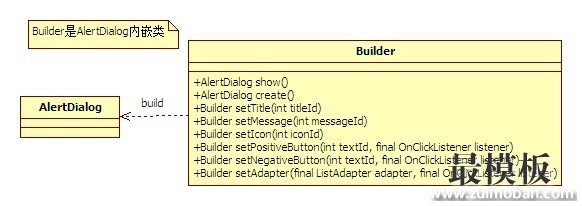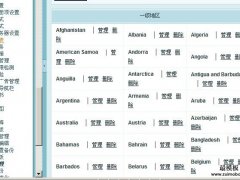建造者模式(Builder Pattern)也叫生成器模式,其定义如下: 我的理解:就是把一个产品(对象)表示(展示)和构建(创建)过程分离开来,这样产品的构建流程相同却可以有不同的产品表示。 应用场景这里举出Android中常见的例子: android中的AlertDialog对话框的构建过程就是建造者模式的典型应用。
UML
看一下Builder源码
public static class Builder {
private final AlertController.AlertParams P;
public Builder(Context context) {
this(context, resolveDialogTheme(context, 0));
}
public Builder(Context context, int themeResId) {
P = new AlertController.AlertParams(new ContextThemeWrapper(
context, resolveDialogTheme(context, themeResId)));
}
//各种set参数方法
setTitle()
...
...
...
/**
* Creates an {@link AlertDialog} with the arguments supplied to this
* builder.
* <p>
* Calling this method does not display the dialog. If no additional
* processing is needed, {@link #show()} may be called instead to both
* create and display the dialog.
*/
public AlertDialog create() {
// Context has already been wrapped with the appropriate theme.
final AlertDialog dialog = new AlertDialog(P.mContext, 0, false);
P.apply(dialog.mAlert);
dialog.setCancelable(P.mCancelable);
if (P.mCancelable) {
dialog.setCanceledOnTouchOutside(true);
}
dialog.setOnCancelListener(P.mOnCancelListener);
dialog.setOnDismissListener(P.mOnDismissListener);
if (P.mOnKeyListener != null) {
dialog.setOnKeyListener(P.mOnKeyListener);
}
return dialog;
}
// 这个show方法是builder对象的,里面封装了create()和show()可以直接调取创建并显示对话框
public AlertDialog show() {
final AlertDialog dialog = create();
dialog.show();
return dialog;
}
}
分析源码可以看到内部类Builder是用来构建这个对话框的: 1、创建builder的时候,会把这个AlertController.AlertParams P;对象P创建new出来 2、在对bilder设置各种参数的时,这些参数都存在了对象P中 3、然后builder参数设置完毕后在调用create方法。 final AlertDialog dialog = new AlertDialog(P.mContext, 0, false); P.apply(dialog.mAlert); // mAlert是外部类中的 这个方法中会首先调用外部类AlertDialog的构造方法,new出一个外部类对象,然后p.apply()方法会将P这个对象作为内部类的属性赋值给AlertController的对象mAlert。这样就完成了一次的构建。 下面是AlertDialog的部分源码
public class AlertDialog extends Dialog implements DialogInterface {
// 这个对象用来承接builder内部所设置的参数
private AlertController mAlert;
//以下几个构造方法决定只能通过内部类builder来构建
protected AlertDialog(Context context) {
this(context, 0);
}
protected AlertDialog(Context context, boolean cancelable, OnCancelListener cancelListener) {
this(context, 0);
setCancelable(cancelable);
setOnCancelListener(cancelListener);
}
protected AlertDialog(Context context, @StyleRes int themeResId) {
this(context, themeResId, true);
}
AlertDialog(Context context, @StyleRes int themeResId, boolean createContextThemeWrapper) {
super(context, createContextThemeWrapper ? resolveDialogTheme(context, themeResId) : 0,
createContextThemeWrapper);
mWindow.alwaysReadCloseOnTouchAttr();
mAlert = new AlertController(getContext(), this, getWindow());
}
}
(责任编辑:最模板) |
Android 中的建造者模式
时间:2016-02-08 15:10来源:未知 作者:最模板 点击:次
建造者模式(Builder Pattern)也叫生成器模式,其定义如下: separate the construction of a complex object from its representation so that the same construction process can create different representations.将一个复杂对
顶一下
(0)
0%
踩一下
(0)
0%
------分隔线----------------------------
- 热点内容
-
- 非全屏Weex页面开发中的Android适配
weex代码中的高度和宽度的单位均为px,然而,在手机屏幕上显示...
- ExpandableListView总结
ExpandableListView是一个垂直滚动显示两级列表项的视图,与ListVi...
- Android使用Bottom Navigation
现在的App设计中,很多都会使用我们的底部导航,也就是我们经...
- 最适合Android开发者的WebApp框架
随着移动端设备越来越多, 微信应用号即将发布, 越来越多的页面...
- Android用ViewPager实现多页面的切换效
Paste_Image.png 说明: ViewPager用于实现多页面的切换效果,该类存...
- 非全屏Weex页面开发中的Android适配
- 随机模板
-
-
 shopex名仕模板
人气:362
shopex名仕模板
人气:362
-
 Prestashop外贸数码电子商城
人气:263
Prestashop外贸数码电子商城
人气:263
-
 Milano外贸Prestasop商城模板
人气:306
Milano外贸Prestasop商城模板
人气:306
-
 ecshop仿米奇网化妆品2014网
人气:549
ecshop仿米奇网化妆品2014网
人气:549
-
 ecshop英文国家地区表,ecs
人气:1266
ecshop英文国家地区表,ecs
人气:1266
-
 shopex仿爱情鸟模板
人气:425
shopex仿爱情鸟模板
人气:425
-
